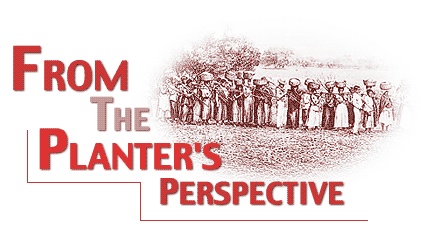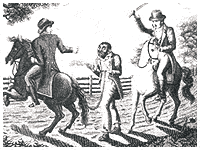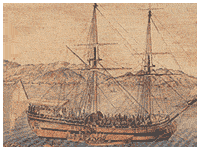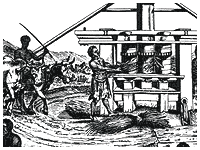 | 
 |
The veil of slavery fell on the Caribbean for several dreadful centuries; centuries in which both the suffering and exploited slaves as well as their exploiters, the planters, faced a great many pressures. Slaves lived in near hopeless misery while the planters, despite enjoying wealth and freedom, stood in constant fear. As the age of slavery neared its end, the planter class was caught with its back against the wall, facing the sword of rebellion. Newly passed laws created the paradox of limited protection of the rights of slaves while also attempting to allow the planters legal measures for deterrence of resistance. These measures, as expected, still usually held violence as the primary and essential tool.
 As a prime example of this late emerging mechanism, we turn to the actual journal of a planter in a former Jamaican slave estate and plantation: the journal of Englishman Matthew Gregory Lewis. M.G. Lewis inherited the estate of Cornwall in the British colony of Jamaica, and took up its management from 1815 though 1817. His journal shows a revealing first hand account of the friction between the slaves and the planters, but more importantly, it shows us how the planters viewed resistance. Within it we learn how British law affected the way planters dealt with their slaves. Ultimately we learn of the main driving factor behind the planters action against their defiant slaves: fear. As a prime example of this late emerging mechanism, we turn to the actual journal of a planter in a former Jamaican slave estate and plantation: the journal of Englishman Matthew Gregory Lewis. M.G. Lewis inherited the estate of Cornwall in the British colony of Jamaica, and took up its management from 1815 though 1817. His journal shows a revealing first hand account of the friction between the slaves and the planters, but more importantly, it shows us how the planters viewed resistance. Within it we learn how British law affected the way planters dealt with their slaves. Ultimately we learn of the main driving factor behind the planters action against their defiant slaves: fear.
In order to understand how the planters responded to slave resistance, one must place their actions in the proper historical context. In the case of Lewis’ narrative, Jamaica had witnessed the abolition of the slave trade just under a decade before his writing of the journal. By then, the British parliament had increasingly been passing laws that, while nonetheless did so in a limited fashion, protected slaves against indiscriminate or overly abusive punishment by their owners. One such law, the Jamaican Consolidated Slave Law of 1795, set clear limits on slave punishment. The fact that abolition limited the inflow of new slaves into the Jamaican colony also meant that planters had a vested interest in preserving the well being of their remaining slaves. As a result of these late legalistic developments, post-slave trade Jamaican planters were more lenient in their punishment of rebellious slaves than during previous time periods. Lewis tells us of runaway slaves that upon return are only slightly reprimanded or, at the worse case scenario of a repeated escapee, the slave is simply sold off without informing the new owner of his or her deviant history. We also hear of a sheep thieving slave that suffers the same fate as his runaway colleagues.
 New laws limited the ability of planters to carry out unchecked discretion. While minor offenses were taken lightly, there were less kindly ways to punish and deter rebellion in 19th century Jamaica. One interesting option opened to the planters as described by Lewis, is the use of slave courts. Described by Lewis as fair and devoid of tricks and legalistic traps, these courts sentenced a slave girl -accused of poisoning her master- to her death. Lewis himself dismissed one of his own overseers for striking a disobedient slave with a broom. Furthermore, slaves had the right to complaint of abuses by their owners to magistrates and often approached Lewis to gain him as a supporter in their plea against neighboring planters. New laws limited the ability of planters to carry out unchecked discretion. While minor offenses were taken lightly, there were less kindly ways to punish and deter rebellion in 19th century Jamaica. One interesting option opened to the planters as described by Lewis, is the use of slave courts. Described by Lewis as fair and devoid of tricks and legalistic traps, these courts sentenced a slave girl -accused of poisoning her master- to her death. Lewis himself dismissed one of his own overseers for striking a disobedient slave with a broom. Furthermore, slaves had the right to complaint of abuses by their owners to magistrates and often approached Lewis to gain him as a supporter in their plea against neighboring planters.
There is, however, a vast difference between what the progressive British laws dictated to the planters and what they actually carried out. Violence was still the main tool of control for the owners, and at its center was the whip. The whip was as common in the fields as the tools used to work the land, and it was in the opinion of many Jamaican planters -if not most- that without it a plantation could not be operated. Lewis tells us of a particularly pious planter that, after abolishing the usage of the whip on his estate as an act of humanist goodwill towards his slaves, decides to return to it or risk being unable to run his plantation. In fact, the planters did not view the usage of the whip as a barbarous practice, and as Lewis points out, many of them justified its use as no different than when it is used on British soldiers and sailors.
M.G. Lewis was, however, no fan of violent means and disapproved of the overseer’s whip being used in his estate. As common sense would dictate, in an oppressive system which forces people to act against their own desires, the way to maintain the will of the oppressing class is through imposition by force. As Lewis abandoned the usage of the whip and other violent means, incidences of slave resistance increased, and he makes a repeated reference to this diminishing obedience. In one example, which Lewis’ blames as the direct result of his policy against the whip, there is a small rebellion by several female slaves refusing to carry out duties and attempting to strangled their driver -a rebellion quenched by the temporary return to the whip. In another case of resistance, after a herd of cattle has wandered into one of the planted fields at night, Lewis as his men are unable to awaken the sleeping slaves to help drive the herd away, resulting in a considerable loss for Lewis. In another almost humorous occasion, 45 of his nearly 300 slaves report to the hospital claiming what his medical staff calls false ailments and pains, in order to avoid the grueling labor. Interestingly enough, the greatest deterrent that Lewis uses to maintain the obedience of his slaves is not through violence but rather by threatening to sell off Cornwall plantation and return to England. His slaves knew well that the chances of another Lewis becoming their master were slim, and that the whip would surely return alongside a new owner.
 Lewis’ “indulgent” character also brought to light the fear that planters had of their enslaved masses. When other planters began seeing a trend in Lewis ameliorating methods towards his slaves, he was called upon to witness a session of the country court, a sort of general assembly. There he learns of a planter whose humanist practices towards his slaves is “promoting disorder and confusion”, “calling the peace of the island”, and “...involved in the [slave] disputes in other states”. The planter of whom they spoke is, of course, Mr. Lewis himself. Outnumbered by their slaves and surrounded by news of rebellions all too close to home, the Jamaican planters did not wish to give any dangerous ideas to their captured laborers. Lewis’ “indulgent” character also brought to light the fear that planters had of their enslaved masses. When other planters began seeing a trend in Lewis ameliorating methods towards his slaves, he was called upon to witness a session of the country court, a sort of general assembly. There he learns of a planter whose humanist practices towards his slaves is “promoting disorder and confusion”, “calling the peace of the island”, and “...involved in the [slave] disputes in other states”. The planter of whom they spoke is, of course, Mr. Lewis himself. Outnumbered by their slaves and surrounded by news of rebellions all too close to home, the Jamaican planters did not wish to give any dangerous ideas to their captured laborers.
How did planters in Jamaica react to displays of resistance by their slaves? Violence was an option always open but with newly-found legal limitations, this was an increasingly less effective tool. Slave courts worked, but their mere existence was a symbol of the weakened power of the planters. As the San Domingo revolution raged on, fear of a bloodshed of equal proportions crossed the minds of the Jamaican planters, who kept eagerly well-informed of the events at their tumultuos neighbor. Unfortunately, Mr. Lewis never witnessed the extinction of
slavery in Jamaica, as he died on a trip back to England a few short years before the entire system was finally dissolved.
|
Lewis, Mathew Gregory. Journal of a West Indian Propietor. London: Printed for John Murray, 1818. (UM Special Collections F1870.L67.c.2)
Sells, William. Remarks on the Condition of the Slaves in the Island of Jamaica. London: J.M. Richardson, Corhili, and Ridgways, Piccadilly, 1823.
Craton, Michael. Searching for the Invisible Man: Slaves and Plantation Life in Jamaica. Cambridge: Harvard University Press, 1978.
|

 |





